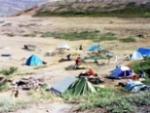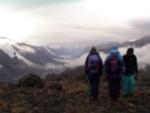Coastal, fjord and inland dwellers
Settlement Patterns in Central West Greenland
By Bjarne Grønnow and Ulla Odgaard
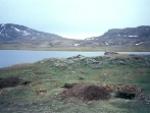
The processes of change of settlement patterns in Central West Greenland are the main theme of this project. Research in the inland of Angujaartorfiup Nunaa, Maniitsoq Municipality, has demonstrated the potential of combining the rich archaeological and ethno historical sources in a direct historical and contextual approach to the study of summer settlement patterns in this "classic" caribou hunting area. Through collaboration with the Greenland National Museum, the results of the studies of the inland areas will be combined with the results of recent surveys along the coasts and fiords in the Maniitsoq Municipality.
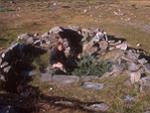
During the field seasons 2001, 2002 and 2003 the project (with the pet name "Habakuk's hunting grounds" after a historic hunter) has concentrated on making reconnaissance in those areas of Angujaartorfiup Nunaa, where no earlier archaeological examinations had been carried out. The greater part of the area is a high plain with peaks up to 1400 m and with many rivers and lakes. It's lying between Kangerlussuaq (Søndre Strømfjord) to the North and three ice caps to the west, south and east and the climate is "arctic desert".
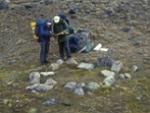
In this deserted landscape we have made reconnaissance by walking along routes and through areas that according to the historical sources from 18th and 19th century were used by the hunters. The result is more than 300 sites, such as base camps where families spent the summer, and hunter's beds and rock-shelters used when on hunting expeditions. Tent rings, meat caches, hunting blinds and hunting drives (as rows of head-cairns) are other groups of features there are plenty of in Angujaartorfiup Nunaa. Two kinds of archaeological features, previously not registered in Greenland, are cairns marking long routes through the landscape and anthropoid rocks – possibly ritual sites – arranged strikingly in the landscape.
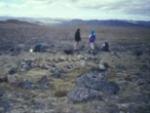
Test excavations have shown that hunters used the area long before historical times. A Carbon-14 sample from a hearth in a stone age Saqqaq tent ring gives the dating 3500 BP, and another from an old Thule culture base-camp 1350 AD.
In 2003 the project included ethno-archaeological studies in Angujaartorfik, a former assembly camp at the coast of Kangerlussuaq, where video-documentation of caribou meat procurement was made.
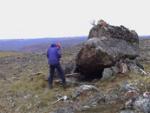
An international team of researchers carried out the fieldwork:
Bjarne Grønnow, Mille Gabriel, Pauline Knudsen and Ulla Odgaard, SILA, Denmark
Clemens Pasda, Jena University, Germany
Kerstin Pasda, München University, Germany
Charlotte Damm, Tromsø University, Norway
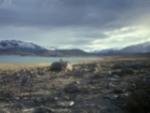
In Angujaartorfiup Nunaa we find a long hunting tradition in an intact and undisturbed landscape, where the archaeological remains are so well preserved you can nearly feel the presence of the hunters. The surveys has made it possible to investigate aspects of mobility- and settlement patterns, territoriality, resource exploitation, hunting ethics and ideology through times. A publication on the results of the project with contributions from Bjarne Grønnow, Pauline Knudsen, Clemens Pasda, Kerstin Pasda and Ulla Odgaard (ed.) is now in preparation.


